 Traduzca esta página al español
usar FreeTranslation.com
Traduzca esta página al español
usar FreeTranslation.com 
 Traduire Cette Page A Français
utilisation FreeTranslation.com
Traduire Cette Page A Français
utilisation FreeTranslation.com 
 Übersetzen Sie Diese Seite Zu Deutsch
Gebrauch FreeTranslation.com
Übersetzen Sie Diese Seite Zu Deutsch
Gebrauch FreeTranslation.com 
Ezekiel's Vision - The Bible story
This version suggests extraterrestial visitors.
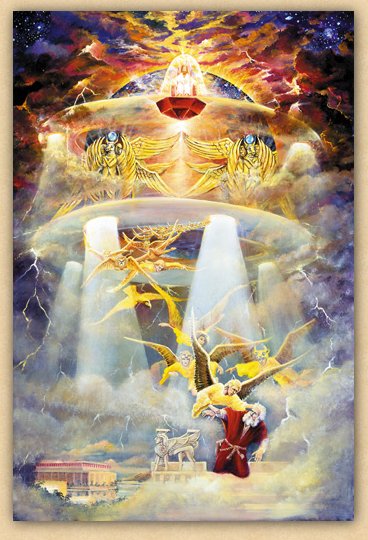 A discussion of UFOs in the Old Testament usually
includes an evaluation of the vision of Ezekiel, who saw UFOs
which resembled "wheels" (Ezekiel 1:11 - 28). This vision does
not fit in very well with descriptions of flying saucers, but
Ezekiel's experiences are different from the pillar of cloud
tradition in that he alone seems to have had the vision. Ezekiel's
vision was not so fundamental to the Hebrew faith as the work of
Moses, although it may have been a valid prophetic experience.
It seems quite logical to suppose that if beings in UFOs spent
forty years developing the Hebrew community of faith, appointed
prophets would quite likely have occasional contact with the
angels of God. But the Biblical faith could have survived
without Ezekiel's vision of "wheels"; without the "pillar of
cloud" of Moses there would have been no Biblical religion.
A discussion of UFOs in the Old Testament usually
includes an evaluation of the vision of Ezekiel, who saw UFOs
which resembled "wheels" (Ezekiel 1:11 - 28). This vision does
not fit in very well with descriptions of flying saucers, but
Ezekiel's experiences are different from the pillar of cloud
tradition in that he alone seems to have had the vision. Ezekiel's
vision was not so fundamental to the Hebrew faith as the work of
Moses, although it may have been a valid prophetic experience.
It seems quite logical to suppose that if beings in UFOs spent
forty years developing the Hebrew community of faith, appointed
prophets would quite likely have occasional contact with the
angels of God. But the Biblical faith could have survived
without Ezekiel's vision of "wheels"; without the "pillar of
cloud" of Moses there would have been no Biblical religion.
Exodus 3:2
"And the angel of the Lord appeared to him in a flame of fire
out of the midst of bush; and he looked, and lo, the bush was
burning, yet it was not consumed.
"This text records that the angel of the Lord was in the
"midst" of the bush.
This word midst is important: the Hebrew
word bush actually means a thicket, suggesting a clump of
bushes, and the "angel" of the Lord was in the midst or middle
of a clump of bushes. In other words, it makes sense to suggest
that the angel of God in the pillar of cloud and of fire which
led the Israelites through the Red Sea and the wilderness had on
occasion settled down on the ground into the midst of a clump
of bushes - a thicket. The UFO in the thicket made the whole
clump of bushes appear to be on fire, but appearently the
thicket was not consumed by the presence of the UFO, and this
combination of circumstances caught - Moses' attention.
The Bible suggests that a UFO, which seemed cloudlike
during the day but which glowed in the dark, served as a beacon
or guide which led the Israelites day and night from Egypt to
the Red Sea. This UFO deliberately lead the Israelites to the
Red Sea, which seemed like a foolish thing to have done because
with the Egyptian army coming up from behind, the Hebrews were
literally caught between the Pharaoh and the deep blue sea. The
Bible says Pharaoh thought the Israelites were "entangled in the
land; the wildness has shut them in"(Exodus 14:3). Pharaoh and
his army moved in for the kill, with the "pillar" having been a
poor guide, unless the being in charge of the UFO knew ahead of
time what would happen at the Red Sea!
The Israelites were convinced that they were finished. They
said to Moses, "Is it because there are no graves in Egypt that
you have taken us away to die in the wilderness?" ( Exodus
14:11) But as Pharaoh's army moved in, God's angel in the UFO
took command of the situation. "Then the angel of God who went
before the host of Israel moved and went behind them; and the
pillar of cloud moved from before them and stood behind them,
coming between the host of Egypt and the host of Israel. And
there was the cloud and the darkness; and the night passed
without one coming near the other all night" (Exodus 14: 19, 20).
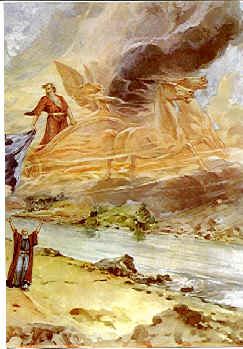 And as they still went on and talked , behold, a chariot of fire
and horses of fire separated the two of them. And Elijah went up
by a whirlwind into heaven".(2 Kings 2:16; 1 Kings 18:12) When
Elijah had apparently finished his life on earth,
we read that "the Lord was about to take Elijah up to heaven by
a whirlind''. Moses and Elijah were separated by history, so
that we need not to expect this brief encounter with a UFO to
have brought forth an immediate "pillar of cloud" response from
the person who seems to have been the lone witness, Elijah. One
gains the impression that it was customary for Elijah to
disappear in some sort of UFO, for Elijah's fellow prophets
ordered a search for Elijah; "it may be, they said, "that the
Spirit of the Lord has caught him up and cast him upon some
mountin or into some valley" One other interesting aspect of the departure
of Elijah in a sort of UFO is the fact that Elijah and Elisha
apparently crossed the Jordan to meet the heavenly whirlwind
and chariot. There were fifty men watching in the distance as
Elijah and Elisha stood next to the river.
And as they still went on and talked , behold, a chariot of fire
and horses of fire separated the two of them. And Elijah went up
by a whirlwind into heaven".(2 Kings 2:16; 1 Kings 18:12) When
Elijah had apparently finished his life on earth,
we read that "the Lord was about to take Elijah up to heaven by
a whirlind''. Moses and Elijah were separated by history, so
that we need not to expect this brief encounter with a UFO to
have brought forth an immediate "pillar of cloud" response from
the person who seems to have been the lone witness, Elijah. One
gains the impression that it was customary for Elijah to
disappear in some sort of UFO, for Elijah's fellow prophets
ordered a search for Elijah; "it may be, they said, "that the
Spirit of the Lord has caught him up and cast him upon some
mountin or into some valley" One other interesting aspect of the departure
of Elijah in a sort of UFO is the fact that Elijah and Elisha
apparently crossed the Jordan to meet the heavenly whirlwind
and chariot. There were fifty men watching in the distance as
Elijah and Elisha stood next to the river.
Numbers 9:15 - "On the day that the tabernacle was set up,
the cloud covered the tabernacle, the tent of the testimony; and
at evening it was over the tabernacle like the appearance of
fire until morning."
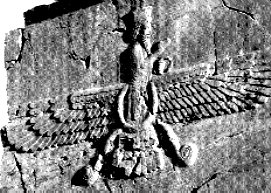 The winged god of war - Enlil/Samael;
Legends surrounding Zoroaster, a prophet of the 6th century B.C.
has some similar reports and description of flying disk, and
flying gods. Ashur, the winged god of war, is very striking and
was later an adaptation of a god before him, called Ahura Mazda.
The winged god of war - Enlil/Samael;
Legends surrounding Zoroaster, a prophet of the 6th century B.C.
has some similar reports and description of flying disk, and
flying gods. Ashur, the winged god of war, is very striking and
was later an adaptation of a god before him, called Ahura Mazda.
Space ships in the Rig Veda
In ancient Hindu text of India, such as the Rig Veda in the
Mahabharata and in the Ramayana there are long descriptions of
Vimanas, which are flying machines that could cover vast
distances and travel forward, upward and downward. They speak
of cars that fly and even instructions how to build them! These
Hindu text are full of such examples of how we have been
visited by outsiders.
Heroes who march in companies, befriending man, with
serpents' fire through strength, ye greet the earth and heaven.
Upon the seats, O Maruts, of your chariots, upon the cars stands
lightning visible as light.
 Such writers as Zecharia Sitchin and Erich von Daniken
have interpeted these tablets to mean we have been visited by a
race of advanced extraterrestrias, and humans were created by
them because their race was dying and needed gold to shield or
protect their planet. So, according to Sitchin and others,
mankind was created by this advanced race of beings to mine for
gold. "We were just slaved." Zecharia Sitchen has wrote numerous
book on this topic and has changed the thinking of thousands of
people. check out "Genesis revisited"
Such writers as Zecharia Sitchin and Erich von Daniken
have interpeted these tablets to mean we have been visited by a
race of advanced extraterrestrias, and humans were created by
them because their race was dying and needed gold to shield or
protect their planet. So, according to Sitchin and others,
mankind was created by this advanced race of beings to mine for
gold. "We were just slaved." Zecharia Sitchen has wrote numerous
book on this topic and has changed the thinking of thousands of
people. check out "Genesis revisited"
Ripon College currently owns 7 cuneiform tablets which
have been translated and are online here
Tablets
The historical records
2048 B.C - Shulgi dies. Marduk moves to the Land of the Hittites.
Abraham ordered to southern Canaan with an elite corps of cavalrymen.
2047 B.C -Amar-Sin (the biblical Amraphel) becomes king of Ur. Abraham
goes to Egypt, stays five years, then returns with more troops.
2041 B.C -Guided by Inanna, Amar-Sin forms a coalition of Kings of the
East, launches military expedition to Canaan and the Sinai. Its leader is the Elamite
Khedor-la'omer. Abraham blocks the advance at the gateway to the Spaceport.
2038 B.C -Shu-Sin replaces Amar-Sin on throne of Ur as the empire disintegrates.
2029 B.C -Ibbi-Sin replaces Shu-Sin. The western provinces increasingly to Marduk.
2024 B.C -Leading his followers, Marduk marches on Sumer, enthrones
himself in Babylon. Fighting spreads to central Mesopotamia. Nippur's Holy of
Holies is defiled. Enlil demands punishment for Marduk and Nabu; Enki opposes,
but his son Nergal sides with Enlil. As Nabu marshals his Canaanite followers to
capture the Spaceport, the Great Anunnaki approve of the use of nuclear weapons.
Nergal and Ninurta destroy the Spaceport and the errant Canaanite cities.
2023 B.C -The winds carry the radioactive cloud to Sumer. People die
a terrible death, animals perish, the water is poisoned, the soil becomes barren.
Sumer and its great civilization lie prostrate. Its legacy passes to Abraham's seed
as he begets -at age 100- a legitimate heir: Isaac.
Time lines for the last 400,000 Years
The Nibiru

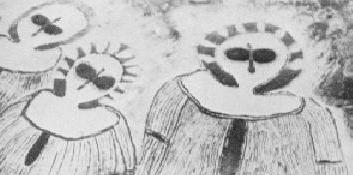 Australian Space gods
Australian Space gods
In Australia there are rock paintings of alien looking creatures.
The paintings are located in the Regent River valley in
Kimberleys, Australia. These are the gods of creation, Vonjinda
and are worshiped by the aborigines in that area.
There are many stories of UFOs and flying disk in almost
every ancient culture and almost every account, these alien
beings have interbreeded with mankind and produced 'super
beings' as their offspring. This kind of tale, we see too
clearly in the Greek Myths and stories of Titans as well in the
Biblical accounts of Genesis 6:4, and the Book of Enoch as well
as other ancient text. In modern society, we have 1000's of
reports each year of UFO sightings. They come in the night,
and in the day. They leave traces such as the image above and
popular 'crop circles'. There is no doubt that something is out
there, but what? What are these things and more imporant just
who or what are the occupants?
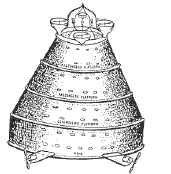 Dr. V. Raghavan, retired head of the Sanskrit Department
of the University of Madras (in India) says that there
is scientifical evidence that Aliens came to Ancient
India. Dr. Raghavan says: "Fifty years of researching
this ancient works convinces me that there are livings
beings on other planets, and that they visited earth
as far back as 4000 B.C." he continues, "In the
Mahabharata (writings), there is notion of divine
lighting and ray weapons, even a kind of hypnotic
weapon. And in the Ramayana (writings), there is a
description of Vimanas, or flying machines, that
navigated at great heights with the aid of quicksilver
and a great propulsive wind. These were space vehicles
are similar to the so-called flying saucers reported
throughout the world today." Arcording to him, Ancient
Indians had very advanced flying machines.
see Vimanas
Dr. V. Raghavan, retired head of the Sanskrit Department
of the University of Madras (in India) says that there
is scientifical evidence that Aliens came to Ancient
India. Dr. Raghavan says: "Fifty years of researching
this ancient works convinces me that there are livings
beings on other planets, and that they visited earth
as far back as 4000 B.C." he continues, "In the
Mahabharata (writings), there is notion of divine
lighting and ray weapons, even a kind of hypnotic
weapon. And in the Ramayana (writings), there is a
description of Vimanas, or flying machines, that
navigated at great heights with the aid of quicksilver
and a great propulsive wind. These were space vehicles
are similar to the so-called flying saucers reported
throughout the world today." Arcording to him, Ancient
Indians had very advanced flying machines.
see Vimanas
The Ramayana even describes a beautiful chariot which
'arrived shining, a wonderful divine car that sped through
the air'. In another passage, there is mention of a chariot
being seen 'sailing overhead like a moon.' "The references
in the Mahabharata are no less astounding:
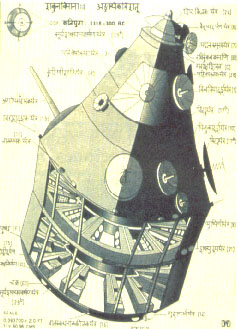 At Rama`s behest, the magnificent chariot rose up
to a mountain of cloud with a tremendous din.` Another passage
reads: `Bhima flew with his Vimana on an enormous ray which
was as brilliant as the sun and made a noise like the thunder
of a storm." In the ancient Vymanka-Shastra (science of
aeronautics), there is a description of a Vimana: "An
apparatus which can go by its own force, from one place
to place or globe to globe." Dr. Raghavan points out,
"The text`s revelations become even more astounding.
Thirty-one parts-of which the machine consists-are
described, including a photographing mirror underneath.
At Rama`s behest, the magnificent chariot rose up
to a mountain of cloud with a tremendous din.` Another passage
reads: `Bhima flew with his Vimana on an enormous ray which
was as brilliant as the sun and made a noise like the thunder
of a storm." In the ancient Vymanka-Shastra (science of
aeronautics), there is a description of a Vimana: "An
apparatus which can go by its own force, from one place
to place or globe to globe." Dr. Raghavan points out,
"The text`s revelations become even more astounding.
Thirty-one parts-of which the machine consists-are
described, including a photographing mirror underneath.
The text also enumerates 16 kinds of metal that are
needed to construct the flying vehicle: `Metals suitable,
lighare 16 kinds. `But only three of them are known to us
today. The rest remain untranslatable." Another authority
who agrees with Dr. Raghavan`s interpretations is Dr.
A.V. Krishna Murty, professor of aeronautics at the
Indian Institute of Science in Bangalore. "It is
true," Dr. Krishna Murty says, "that the ancient
Indian Vedas and other text refer to aeronautics,
spaceships, flying machines, ancient astronauts.
"A study of the Sanskrit texts has convinced me
that ancient India did know the secret of building
flying machines-and that those machines were patterned
after spaceships coming from other planets."
The Vedic traditions of India tell us that we
are now in the Fourth Age of mankind. The Vedas call
them the "The Golden Age", "The Silver Age", and "The
Bronze Age" and we are now, according to their
scriptures in the "The Iron Age". As we approach
the end of the 20th century both Native Americans,
Mayans, and Incans, prophecies claim that we are
coming to the end of an age. Sanskrit texts are
filled with references to Gods who fought battles
in the sky using Vihmanas equipped with weapons
as deadly as any we can deploy in these more enlightened times.
For example, there is a passage in the Ramayana which reads:
The Puspaka car that resembles the Sun and belongs
to my brother was brought by the powerful Ravan; that
aerial and excellent car going everywhere at will....
that car resembling a bright cloud in the sky."..
and the King [Rama] got in, and the excellent car at
the command of the Raghira, rose up into the higher atmosphere."
In the Mahabharata, an ancient Indian poem of
enormous length, we learn that an individual named
Asura Maya had a Vimana measuring twelve cubits in
circumference, with four strong wheels. The poem is
a veritable gold mine of information relating to
conflicts between gods who settled their differences
apparently using weapons as lethal as the ones
we are capable of deploying.
Apart from 'blazing missiles', the poem
records the use of other deadly weapons. 'Indra's
Dart' operated via a circular 'reflector'. When
switched on, it produced a 'shaft of light' which,
when focused on any target, immediately 'consumed
it with its power'. In one particular exchange,
the hero, Krishna, is pursuing his enemy, Salva,
in the sky, when Salva's Vimana, the Saubha is
made invisiblein some way. Undeterred, Krishna
immediately fires off a special weapon: 'I
quickly laid on an arrow, which killed by
seeking out sound'.
Many other terrible weapons are described,
quite matter of factly, in the Mahabharata, but
the most fearsome of all is the one used against
the Vrishis. The narrative records:
Gurkha flying in his swift and powerful Vimana
hurled against the three cities of the Vrishis
and Andhakas a single projectile charged with all
the power of the Universe. An incandescent column
of smoke and fire, as brilliant as ten thousands
suns, rose in all its splendor. It was the unknown
weapon, the Iron Thunderbolt, a gigantic messenger
of death which reduced to ashesthe entire race of
the Vrishnis and Andhakas.
It is important to note, that these kinds of records
are not isolated. They can be cross-correlated with
similar reports in other ancient civilizations.
...see Ancient writings
For example, how did the chronicler of the Mahabharata know
that a weapon capable of punishing a country with a twelve years'
drought could exist? And powerful enough to kill the unborn in their
mothers womb? This ancient Indian epic, the Mahabharata, is more
comprehensive than the Bible, and even at a conservative
estimate its original core is at least 5,000 years old.
It is well worth reading this epic in the light of the
present day knowledge.
We shall not be surprised when we learn in the
Ramayana that Vimanas, i.e. flying machines,
navigated at great heights with the aid of
quicksilver and a great propulsive wind. the
Vimanas could cover vast, distances and could
travel forward, upward and downward. Enviably
maneuverable space vehicles!.
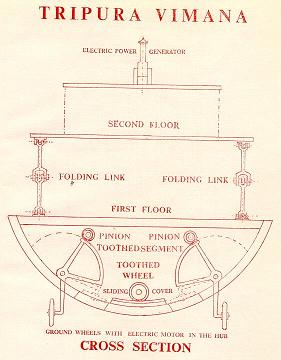 This quotation comes from the translation
by N. Dutt in 1891: "At Rama's behest the
magnificent chariot rose up to a mountain of
cloud with a tremendous din.." We cannot help
noticing that not only is a flying object mentioned
again but also that the chronicler talks of a
tremendous din.
This quotation comes from the translation
by N. Dutt in 1891: "At Rama's behest the
magnificent chariot rose up to a mountain of
cloud with a tremendous din.." We cannot help
noticing that not only is a flying object mentioned
again but also that the chronicler talks of a
tremendous din.
Here is another passage from the Mahabharata:
"Bhisma flew with his Vimana on an enormous ray
which was as brilliant as the sun and made a noise
like the thunder of a storm." ( C.Roy 1899).
Even imagination needs something to start
off. How can the chronicler give descriptions
that presuppose at least some idea of rockets
and the knowledge that such a vehicle can ride
on a ray and cause a terrifying thunder?
Certain numerical data in the Mahabharata
are so precise that one gets the impression that
the author was writing from first-hand knowledge.
Full of repulsion, he describes a weapon that
could kill all warriors who wore metal on their
bodies. If the warriors learned about the effect
of this weapon in time, they tore off all the
metal equipment they were wearing, jumped into
a river, and washed everything they were wearing,
and everything they had come in contact with
very thoroughly. Not without reason, as the
author explains, for the weapons made the hair
and nails fall out. Everything living, he
bemoaned, became pale and weak. see
Vimanas 2

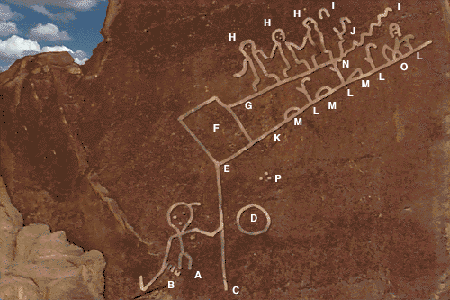 There is a sandstone cliff, near second mesa on the Hopi Reservation in
Arizona. On this cliff is etched a picture of the past, persent, and the future.
This site is more commonly known as Hopi Prophecy Rock. The petroglyph
depicts the Hopi as emerging from the underground to the surface of the earth.
The actual place for this event is a religious site located in the Grand Canyon.
The Sioux also say they emerged from underground at a place in the Black Hills
known today as Wind Cave.
There is a sandstone cliff, near second mesa on the Hopi Reservation in
Arizona. On this cliff is etched a picture of the past, persent, and the future.
This site is more commonly known as Hopi Prophecy Rock. The petroglyph
depicts the Hopi as emerging from the underground to the surface of the earth.
The actual place for this event is a religious site located in the Grand Canyon.
The Sioux also say they emerged from underground at a place in the Black Hills
known today as Wind Cave.
The story depicted on the prophecy rock continues on by showing
how the leading clans of the Hopi migrated in the 4 directions, then turned left--
-forming a Swastika symbol. The clans that followed migrated in the 4 directions-
-then turned left---forming reverse Swastika symbol. After journeying in the 4
directions, they were to return to the center. When they reach the center it will
be the end of the fourth age.
The Sioux, like the Hopi, traveled in the 4 directions after emerging
from the underground. The Sioux also believe that man has evolved through
4 ages, calling them the Age of Fire, Age of Rock, Age of the Bow, and
Age of the Pipe. The length of each age is unknown, but the prophecy is that
during the time of each age, man would gradually become a "two-heart".
The Hopi Prophecy Rock clearly depicts three "two-heart" individuals
. A two-hearted person is one who thinks with his head rather than his heart
. This is in reference to the left-brain function of analytical thinking. A person who
think with his heart usese the right-brain function of intuitive thinking. Currently
modern man is out of balance because we live in a left brained dominated society.
We place more emphasis on left-brain modes of thinking vs. right-brain modes of thought.
The Hopi Prophecy Rock shows a junction where the two-hearted people
have a choice of choosing to start thinking with their hearts or continue to think with
their heads only. If they chose the latter, it will lead to self-destruction; if they chose
to think with their hearts they would gradually return to the natural way and their own survival.
On the Hopi Prophecy Rock are 3 circles which represent 3 world-shakings.
The story is that people of the Earth would reach a time when they would lose the
story of how "we are all related". The Creator would then cause 3 world-shakings
to remind the people of our relatedness.
The first world-shaking would be recognized when a bug on ribbon is
tossed into the air. This is interpretated as an airplane. The time when airplanes
were first used in war was World War I. So World War I would be the first world-shaking.
The second world-shaking would be recognized when man used the
Hopi migration symbol (swastika) in war. This was World War II, which is the
second world-shaking. The great Oglala Sioux holy man, Nicholas Black Elk,
had also foreseen the coming of World War I & II.
The third world-shaking would be recognized by a red cover or cloak
The constellation of Orion's belt is the area of the sky known to the
Sioux as the Heart of the White Buffalo constellation. The White Buffalo legend
states that a sacred maiden brought a holy pipe to be used by the Sioux. When
she departed she said she would return to help the people when they werer in
trouble and turmoil. As she turned to leave she turned into a black buffalo,
then a red buffalo, then a yellow buffalo, and finally into a white buffalo.
Then she went back up into the clouds.
In August of 1994 a white buffalo was born in Wisconsin. Two more were born in May
1996 in South Dakota. One died but the other lived. May 2004,
Another white buffalo has been born. Oglala Sioux holy man Dawson
No Horse, stated that as we move into the next century, times would be very difficult.
Sioux holy man, Black Elk, foresaw the Sacred Hoop of the world's nations
coming together soon--- a reference to the thousand years of peace that is to
follow the third-world shaking.
The rest of the story..
Hopi Indian Prophecy Rock

The first cities in the world
Historical/archeological documentation
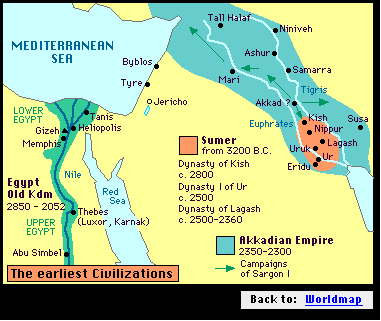 Here dynasties are given for Kish, Uruk, Ur, and Lagash.
The early history of all these cities is mythologized in later
documents. Thus, Gilgamesh might be regarded as a purely
legendary figure if he did not also occur in the ordinary king
lists. There is also some trouble, as in Egypt, reading the
names. The obscurity of early Sumer is compounded by later
misconceptions. The Biblical expression, "Ur of the Chaldees,"
although used by the great excavator of Ur, C. Leonard Woolley,
for the title of a book about the city (Norton Library, 1965),
is extremely anachronistic and misleading.
Here dynasties are given for Kish, Uruk, Ur, and Lagash.
The early history of all these cities is mythologized in later
documents. Thus, Gilgamesh might be regarded as a purely
legendary figure if he did not also occur in the ordinary king
lists. There is also some trouble, as in Egypt, reading the
names. The obscurity of early Sumer is compounded by later
misconceptions. The Biblical expression, "Ur of the Chaldees,"
although used by the great excavator of Ur, C. Leonard Woolley,
for the title of a book about the city (Norton Library, 1965),
is extremely anachronistic and misleading.
Ur was originally a
city of the Sumerians, not of the Chaldeans. The latter were
actually Aramaeans, who did not appear in Mesopotamia until
nearly a thousand years after the end of the Sumerians as a
distinct linguistic community. The Chaldeans dominated
Mesopotamia in the "Neo-Babylonian" Period, not only long after
the Sumerians but also long after any reasonable date for
Abraham -- if Abraham came from "Ur of the Chaldees," this must
be a different Ur, already Aramaean in Abraham's day, or it is
just applying an anarchronistic epithet to a city that later
was associated with the Chaldeans. The Sumerian language itself
was neither Semitic nor Indo-European, a representative of a now
vanished pre-historic language family that may have also
included the Elamite, Kassite, Hurrian, and Urartuan languages.
History begins at Sumer because the Sumerians were undoubtedly
the first to have a functioning system of writing. The origins
of this are now plausibly explained by Denise Schmandt-Besserat
(cf. Before Writing, Volume I, From Counting to Cuneiform,
University of Texas Press, 1992). For purposes of accounting,
contracts, shipping, etc., little clay models were made of the
kinds of commodities involved. For convenience, these models
were then placed in clay wrappers. Then, so that the contents
of the wrappers could be known without breaking them, little
drawings of the models began to put on the wrappers. Soon it
became obvious that the little drawings by themselves made
the models superfluous.
The stylization of the models had
already produced a certain abstraction and stylization in the
drawings, which thus became proto-cuneiform -- a system already
pre-adapted to representing numbers as well as concepts. Since
thousands of the clay models have been found, the evidence for
the process is abundant. No such antecedents have been found
in Egypt or India, where writing began soon after the Sumerian
precedent. It is hard not to conclude that Sumerian influence,
with the evidence of Sumerian artifacts to prove it, sparked
the development of writing in those places.
"Akkad
One of Sargon's successors also had a significant name:
Shar- kalli- sharri means "king of all kings." Shortened to
just "king of kings," this became a standard title for later
Assyrian and then Persian monarchs. It even survived in Modern
Persian as Shâhanshâh.
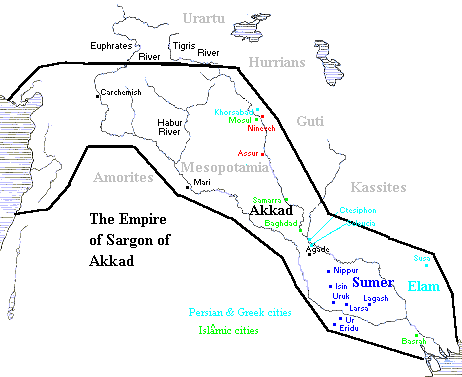
| Known Dynasty of Akkad |
Sharru-kîn, Sargon |
2334-2279 |
Rimush |
2278-2270 |
Manishtusu |
2269-2255 |
Narâm-Sîn |
2254-2218 |
Shar-kalli-sharri |
2217-2193 |
[interregnum, Guti invasion, |
c.2193] |
Shu-Turul |
2168-2154 |
Ur-nammur |
2113-2096 |
We believe there are king's names that are missing from
this list - namely Marduk.
This next list does include Enlil but it doesn't seem to be old enough.
Kassite Dynasty or
Dynasty III of Babylon |
Agum II |
c.1570 |
Burnaburiash I |
Kashtiliash III |
Ulamburiash |
Agum III |
Kadashman-harbe I |
Karaindash |
Kurigalzu I |
Kadashman-Enlil I |
Burnaburiash II |
1375-1347 |
Karahardash |
1347-1345 |
Kurigalzu II |
1345-1324 |
Nazimaruttash |
1323-1298 |
Kadashman-Turgu |
1297-1280 |
Kadashman-Enlil II |
1279-1265 |
Kudur-Enlil |
1265-1255 |
Shagarakti-Shuriash |
1255-1243 |
Kashtiliash IV |
1243-1235 |
|
Assyrian governors, 1235-1227 |
Enlil-nadin-shumi |
Adad-shuma-iddina |
Adad-shuma-us.ur |
1218-1189 |
Melishipak |
1188-1174 |
Marduk-apal-iddina I |
1173-1161 |
Zababa-shuma-iddina |
1161-1159 |
Enlil-nadin-shhê |
1159-1157 |
see Kings of Babylon or Kassites
and The Earliest Civilizations
which has a list from the first dynasty of Kish which dates to 2740BC.
Abraham's great grandfather Raguel was married to Ur-nammu's
daughter. He is on the first list. As for the rest - The
chronology is poorly known.
"So when the final compilation of the Bible appeared
during the years after returning from the Babylonian exile
(around 520 BCE). The biblical authors incorporated their
philosophy of one deity, Yahweh, into the copies of the scrolls.
Whatever attributes a previous god may have had, was retained
and given to Yahweh on paper. If the story was holy and the
deeds were attributed to Anu, Enki, Enlil, Inanna or Marduk it
became the property of the Elohim or Yahweh. Probably Elohim
was a clue to uncover those stories that showed an earlier
influence from Mesopotamia. Why not just give one name to all
the other gods mentioned and save much time? Remember the Bible
is trying to prove there is only one god, which is the point of
the document. So we can accomplish this by putting all
individual names into one general term, plural of course, and
for the priests with the secret knowledge that know for
themselves, we just incorporated the great stories the public
knows and made them specific to our culture and our congregation.
Who would know about the older tablets, who would know we
borrowed? "
" This plan did work until the late 1880's, and early 1900's when
archeologists started to finally dig out the texts in their
original tablet form and the scholars translated them. They
were astonished to find so much of the source material for the
Bible. This plan worked for more than 2,000 years, most people
thought the biblical stories were original to the Bible. Even
now people are astonished when I tell them there are stories
of semi human/semi divine characters and stories of resurrection
from 2000 - 3000 years before the time of Jesus and even
Abraham."
Early Dynastic I
Ante-diluvian kings, legendary, or earlier than ca.
the 26th century BC. Their rules are measured in sars -
periods of 3600 years - the next unit up after 60 in
Sumerian counting (3600 = 60x60), and in ners - units of 600.
"After the kingship descended from heaven, the kingship was
in Eridug. In Eridug, Alulim became king; he ruled for 28800 years."
Alulim of Eridug: 8 sars (28800 years)
Alalgar of Eridug: 10 sars (36000 years)
En-Men-Lu-Ana of Bad-Tibira: 12 sars (43200 years)
En-Men-Ana 1, 2
En-Men-Gal-Ana of Bad-Tibira: 8 sars (28800 years)
Dumuzi of Bad-Tibira, the shepherd: 10 sars (36000 years)
En-Sipad-Zid-Ana of Larag: 8 sars (28800 years)
En-Men-Dur-Ana of Zimbir: 5 sars and 5 ners (21000 years)
Ubara-Tutu of Shuruppag: 5 sars and 1 ner (18600 years)
Zin-Suddu 1
1:These two names are present on slightly over half of the
versions of the sumerian king lists, but not on others.
2:In the place of En-Men-Ana in some versions of the list is the
name Kichu-Ana. from.. The List
This list does not give dates just the Kings and how long they ruled.
 The modern version of the Bible was probably read by Ezra (about
464 BCE) at the inauguration of the Second holy temple in
Jerusalem. Obviously scholars disagree with the exact dating.
The modern version of the Bible was probably read by Ezra (about
464 BCE) at the inauguration of the Second holy temple in
Jerusalem. Obviously scholars disagree with the exact dating.
With all those tablets that I spoke about before, many different
copies of them were found with the same stories. The root to
those stories is the Sumerian culture, but after the culture
dies off the stories moved to the Akkadians, although they still
wrote all the religious documents in the Sumerian language for
hundreds of years after Sumerian was not a publicly spoken
language. Later on with King Gudea, there was a resurgence of
the Sumerian language (2,122 - 2,141 BCE). Then the stories
moved to the Assyrians, Babylonians, Hittites, Canaanites,
Hebrews, etc. Archaeologists found translation tablets that
had dictionaries carved on them, they said this word in Sumerian
is this word in Akkadian, this word in Akkadian is this word in
Assyrian, etc.
Many tablets were broken in pieces and fragmented so it
took many years to connect the pieces from the museums around
the world and put the texts together. But some texts were
found in libraries of clay tablets, where they found a shelf
full of intact texts, with the catalog list at the front of the
shelf. The index list told archaeologists what tablets were
missing from the shelf. Obviously the archeologists were amazed
to dig up complete libraries of carved clay tablets. (This
picture shows many carved texts sitting on shelves. This is
in a museum in Turkey.)
Adamu and Adapa are Sumerian names and characters, the
original form of the name Adam from the Bible. Adam is always
translated as "Man" in English. In Hebrew the word Adama can
mean earth (dust of the ground) and Adom is red (like blood)
and the word Dam means blood. Do you see how the root name of
Adam is closely linked to other words? These double meanings
will be important later on.
Heaven, sky, star is An, Anu, the city know as Heliopolis
in Egypt used to be called An, or Anu. (The chief worship site
of the god Re "Ra".) (Universe is a compound word made up of
An-Ki, meaning Heaven and Earth.)
Dumuzi - Sumerian god, used for name of Hebrew month as
Tammuz. Crying for Tammuz is mentioned in Bible, Ezekiel 8:12
(about the same time as the Babylonian exile). They were not
crying for the name of a month. They were crying in remembrance
of Dumuzi the husband of Inanna who was killed and not able to
be revived.
The Sumerian god Utu (meaning the [visible] sun) is the
same as Shamash in Akkadian; he used the celestial symbol of the
solar disk as his representation. The god name Shamash is the
same as the Hebrew word for the sun, Shemesh. Imagine that, the
word for sun is the same as the god who used the symbol of the
sun.
E-din, E-means house, Din means righteous or pure. The
Garden of Eden. In Hebrew Din is law; House of Law is like
saying courthouse. (Some of you may have heard of the word
Moujahadin, which is an Arabic word meaning holy warrior or
righteous warrior. This is the name of the Arabic fighters in
Afghanistan that the U.S. supported to fight off the Russian
invasion.)
The connection to the Tower of Babel:
In Gen 11:1, it says, in my new translation (The Stone
Edition, Tanach, ArtScroll series), "The whole Earth was of one
language of common purpose. And it came to pass, when they
migrated from the east they found a valley in the land of Shinar
(Sumer) and settled there." Later on, Yahweh saw what the humans
were doing and said "Behold they are one people with one
language for all... come let us (plural) descend and there
confuse their language, that they should not understand each
other."
In Sumerian Mythology by Samuel Noah Kramer from a tablet
that was in the Ashmolean museum, "... Harmony-tongued Sumer...
To Enlil in one tongue gave speech...” a few lines later "...
Changed the speech in their mouths, put contention into it,
into the speech of man that had (until then) been one."
Was it Yahweh or Enlil that changed the speech of man?
In this case Enlil was changed into Yahweh.
From "Myths from Mesopotamia" by Stephanie Dalley, Epic
of Creation, Marduk says "... Let me put blood together and
bones too, let me set up primeval man: Man shall be his name..
.", "... The work of the gods shall be imposed on him..."
In Atra Hasis, "... Nintu mixed clay, with her flesh and blood,
they heard the drumbeat forever after, a ghost (soul) came into
existence from the god's flesh and she (Nintu) proclaimed it a
living sign." Later on "... I myself created (it), my hands
have made (it)..." Remember the meaning of Adom meaning red,
it matches up with the use of blood here in both versions.
Also the word bone used here is "is-si-im[tu]m" which
corresponds to the Hebrew "etzem", "bone" used in Genesis 2:23,
in the phrase "etzem me-atzami", "bone of my bones." Stephanie
Dalley mentions a possible word play being used here, ghost is
"etemmu" and "temu" is intelligence. So the line above could be
read "... an intelligence came into existence from the god's
flesh."
Genesis 1:26, Elohim said "Let us make man (Adam) in our
image, after our likeness..." later on, "... so Elohim created
the man (Adam) in his image, in the image of the Elohim, he
created him, male and female, he created them." Gen 2:7, "And
Yahweh Elohim formed the man (Adam) of dust from the ground,
and he blew into his nostrils the soul of life and the man
(Adam) became a living being." Gen 2:15, "Yahweh Elohim took
the man (Adam) and placed him in the Garden of Eden, to work
it and to watch it." Remember the meaning of "Adama", "earth"
or "dust" as used here. The comparison of "blew into his
nostrils the soul of life" is very similar to "a ghost (soul)
came into existence from the god's flesh."
Both stories have the same theme, man is created using
ingredients, and put to work for the god(s). From L.W. King,
"According to each account the existence of a watery chaos
preceded the creation of the universe; and the Hebrew word
Tehom, translated as "the deep" is the equivalent of the
Babylonian Tiamet, the monster of the deep personifying chaos
and confusion." Later on King says, "... it may here be added
that the employment by Marduk, the creator, of his own blood in
the creation of man may perhaps be compared to the Hebrew
account of the creation of man in the image and likeness of
Elohim. Moreover, the use of the plural in the phrase "let
us make man" may be compared with the Babylonian narrative
which relates that Marduk imparted his purpose of forming man
to his father Ea (Enki), whom he probably afterwards instructed
to carry out the actual work of man's creation."
There are so many Sumerian influences, please read
anything written by Samuel Noah Kramer, my favorite is, "History
Begins at Sumer, 39 Firsts Recorded in Man's History," this
will show you influences in the modern world that began in Sumer.
The Babylonian Epic of Gilgamesh. King Gilgamesh seeks to
become immortal, after the death of his friend Enkidu, but
fails. This is still a poignant story, since human beings still
face loss and grief and death, just as did Gilgamesh. Indeed,
Enkidu's vision of death is still chilling:
There is the house whose people sit in darkness; dust is their
food and clay their meat. They are clothed like birds with
wings for covering, they see no light, they sit in darkness.
I entered the house of dust and I saw the kings of the earth,
their crowns put away for ever... [N. K. Sanders, Penguin, 1964,
p. 89]
More about the Elohims and this entire article..
The work of Zecharia Sitchin - A debate.



View My Guestbook Sign My Guestbook
Sign My Guestbook
Search this site
NO PART OF THIS SITE MAY BE COPIED OR REPRODUCED, IN WHOLE OR IN PART
WITHOUT THE EXPRESS WRITTEN APPROVAL OF THE WEBMASTER...
© COPYRIGHT 1999 - 2010 c.i.c.ALL RIGHTS RESERVED